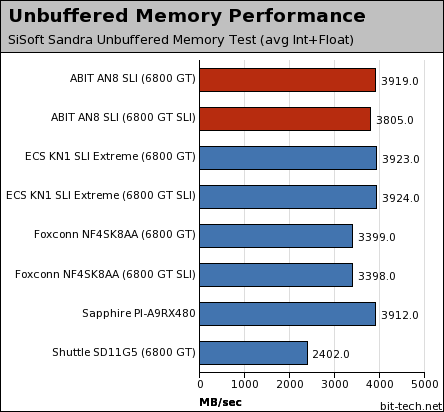Testing Methods:
With the exception of SiSoft Sandra's unbuffered memory bandwidth benchmark - which, incidentally, measures real memory bandwidth when you need it most - all of our benchmarks have been engineered to give you numbers that you are likely to find useful when actually using the products we have evaluated in the real world. There are plans to increase the number of benchmarks over time and we're running additional tests that will not be published until we have enough products to make a reasonable comparison.We are also focusing a lot more of our time on evaluating the stability of the motherboards (and platforms) using a stress test designed to highlight any of the potential weaknesses that the product may have. That involves a gradually increasing amount of stress starting with Prime95 and expanding to IOMeter and 3DMark03 if all is well. This is to ensure that all parts of the system are stressed simultaneously over a period of time.
We believe that the consumer is never likely to subject their platform to this level of stress and we are not expecting every product to complete an entire extended stress test. However, most poorly engineered products fail within the first couple of hours, or even minutes, allowing us to make a conscious decision on whether a motherboard (or platform) is worth your money, regardless of how well it performs in our benchmarks.
Test Setup:
AMD Athlon 64 4000+ (operating at 2400MHz - 12x200); ABIT AN8-SLI; 2 x 512MB Corsair 3200XL Pro (operating in dual channel with 2.0-2-2-5-1T timings); NVIDIA GeForce 6800 GT (operating at 350/1000MHz); Western Digital 74GB Raptor 10,000RPM SATA 150 Hard disk drive; Windows XP Professional Service Pack 2; DirectX 9.0c; NVIDIA ForceWare 71.89 WHQL.AMD Athlon 64 4000+ (operating at 2400MHz - 12x200); Sapphire PI-A9RX480; 2 x 512MB Corsair 3200XL Pro (operating in dual channel with 2.0-2-2-5-1T timings); NVIDIA GeForce 6800 GT (operating at 350/1000MHz); Western Digital 74GB Raptor 10,000RPM SATA 150 Hard disk drive; Windows XP Professional Service Pack 2; DirectX 9.0c; NVIDIA ForceWare 71.89 WHQL.
AMD Athlon 64 4000+ (operating at 2400MHz - 12x200); ECS KN1 SLI Extreme; 2 x 512MB Corsair 3200XL Pro (operating in dual channel with 2.0-2-2-5-1T timings); NVIDIA GeForce 6800 GT (operating at 350/1000MHz); Western Digital 74GB Raptor 10,000RPM SATA 150 Hard disk drive; Windows XP Professional Service Pack 2; DirectX 9.0c; NVIDIA ForceWare 71.89 WHQL.
AMD Athlon 64 4000+ (Clawhammer, 1MB L2); Foxconn WinFast NF4SK8AA-8EKRS (NVIDIA NForce 4 SLI); 2 x 512MB Corsair 3200XL Pro (operating at 400MHz with 2.0-2-2-5-1T timings); NVIDIA GeForce 6800 GT (operating at 350/1000MHz); Western Digital Raptor 74GB; Windows XP Professional Service Pack 2; DirectX 9.0c; NVIDIA ForceWare 71.89 WHQL.
Intel Pentium M 2.13GHz (133x16, 2MB L2); Shuttle SD11G5; 2 x 512MB Corsair 5400UL DDR2 (operating at 533MHz in dual channel with 3.0-2-2-8 timings); NVIDIA GeForce 6800 GT (operating at 350/1000MHz); Western Digital Raptor 74GB; Windows XP Professional Service Pack 2; DirectX 9.0c; NVIDIA ForceWare 71.89 WHQL, Intel Inf 7.00.1.
Memory Performance:

Stability & Overclocking:
Stability was as you’d expect from an ABIT product: rock solid. We ran loops of Prime95, I/Ometer and FarCry for hours and it wouldn’t falter. We did have an issue with Windows Media Player running at 99% CPU load when trying to play HD WMV9 streams, but the latest BIOS fixed that problem for us. Admittedly, this means that the board isn't 100% compatible with everything out of the box, but ABIT have been quick to clear up any issues.Overclocking was pretty successful. We took the CPU limits out of the equation by lowering the multiplier enough to keep it just under stock speeds, and also lowered the memory timings enough to make them a non-issue, while increasing the voltages where necessary. We managed to get the board to 245MHz HTT, keeping the HTT at 1GHz/16bit bidirectional. This gave us a HyperTransport bus speed of 1225MHz.
At this speed the board was still fully stable to Prime95 torture testing. At 248MHz HTT we couldn't get the board to boot. In fact, anything above 245MHz HTT wasn't fully stable. Remember that we're using the oldest "CG" cored 130nm Clawhammer 4000+ which isn't the best overclocking chip on the planet, so those with the new socket 939 Opterons might have a bit more luck than we did.

MSI MPG Velox 100R Chassis Review
October 14 2021 | 15:04






Want to comment? Please log in.